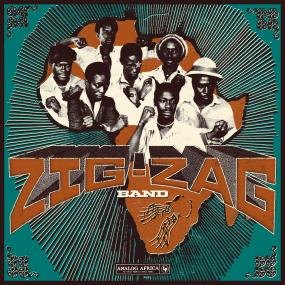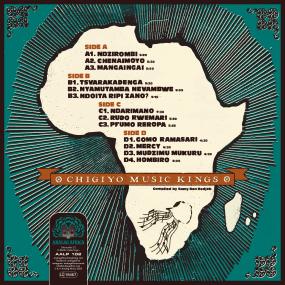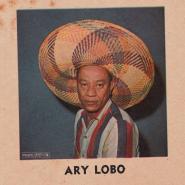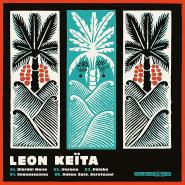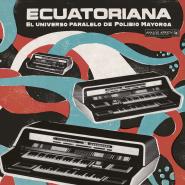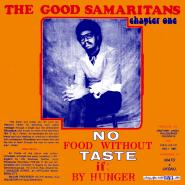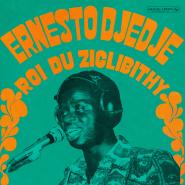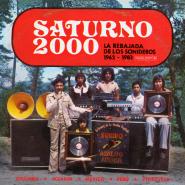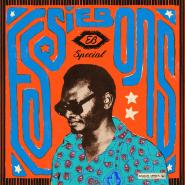CHIGIYO MUSIC KINGS by ZIG-ZAG BAND
| SKU | 141533 |
| Artist | ZIG-ZAG BAND |
| Title | CHIGIYO MUSIC KINGS |
| Label | ANALOG AFRICA |
| Catalog # | AALP 102LE |
| Tag | |
| Release | W 45 - 2025 |
| Format | Vinyl - EU2LP |
| EAN Barcode | 4260126062139 |
| Benelux exclusive, Import | |
| € 39,99 | incl. VAT, excl. shipping |
Tracks
- ndzirombi
- chenaimoyo
- mangaingai
- tsavarakadenga
- nyamutamba newamwe
- ndoita ripi zano
- ndarimano
- rudo rwemari
- pfumo reropa
- gomo ramasari
- mercy
- mudzimu mukuru
- hombiro
Description
2000 copies limited edition release, designed by São Paulo’s own Magrão, comes as a double-140g LP, housed in a striking three-colour screen-printed gatefold cover manufactured in Greece
Accomplished musical documenters Analog Africa shine a long-overdue spotlight on the trailblazers of Zimbabwe's Chigiyo sound with this lovingly curated new collection. Emerging from Kwekwe in the 1980s, the group fused reggae grooves with Shona chants, mbira-inspired guitars and bold brass to create a style uniquely their own. Anchored by legendary guitarist Gilbert Zvamaida, Zig-Zag's music carried spiritual weight and infectious energy with classics like 'Gomo Ramasare' and 'Mudzimu Mukuru' shaping the country's cultural landscape. This lovingly curated compilation revives their groundbreaking catalogue and celebrates their fearless creativity while introducing a new generation to one of Zimbabwe's most distinctive and visionary bands.
====================================================================
"In 2002, I traveled to Zimbabwe with my friend Marc, a fellow musician. After a month-long record safari, he insisted that the highlight of the entire trip was discovering the Zig-Zag Band. At the time, I was so immersed in the raw, gritty Chimurenga sound that his comment barely registered. Fast forward twenty years and I found myself back in Zimbabwe, this time with Volkan who after another digging trip, told me that despite all the music we had discovered, it was the Zig-Zag Band that stuck with him the most. Two people — separated by two decades — coming to the same conclusion? That couldn’t be a coincidence. This time, I had no choice but to listen. What was so special about this band? I was about to find out.
And so, during long, mellow Hararean nights — fueled by natural Zimbabwean ganja and tropical juices — I dove into Zig-Zag’s musical output and within a few days, I was completely in love. Eager to understand more about this kind of music, I went to see Daniel Marire, the archive manager at ZBC (Zimbabwe Broadcasting Corporation) to ask if he could help me with selections of Zimbabwean reggae but was stopped in my tracks when he reminded me that the sound I was after was no reggae but a style called Chigiyo; “These vocals and chants you hear in Zig-Zag’s music are deeply rooted in Shona culture,” he explained, “and the guitars are played in such a way as to mimic the traditional mbira scales. It’s basically reggae but different”.
Now, I’ll be the first to admit I’m no reggae specialist and if I were to put together a compilation of Chigiyo music, how would the reggae heads around the world react to it? There was only one way to find out. I reached out to Magrão — an excellent DJ from São Paulo with plenty of Jamaican trips under his belt — and asked what he thought of this music. At the time, I had rented an apartment right next to the ZRP’s (Zimbabwe Republic Police) forensic science lab — which also houses the ballistics division. So, while I was sending music clips to Magrão and anxiously waiting for his thoughts, the police were conducting ballistic profiling tests and firing super loud live rounds in the middle of the night.
Finally Magrão’s message came through and it was enough to understand that I was onto something special: “What a bassline, so heavy! Is this from Zimbabwe? They’re playing around with reggae and dancehall — totally my style — and I love how it’s mixed with traditional elements. That sound is dynamite…release it!”
Energised, I began searching for the musicians behind the Zig-Zag Band and It didn’t take long to find out that all the original members — except for one — had sadly passed away. The sole surviving member being Gilbert Zvamaida, the legendary guitarist and founding force behind the group. We started video chatting over WhatsApp, and Gilbert always appeared super laid-back, often lounging shirtless on his sofa, sharing stories of his musical journey — tales of traveling across the country, spreading the sound he helped pioneer throughout Zimbabwe.
The band emerged in the early 1980s, a time when Zimbabwe was forging its post-independence identity, and quickly established itself as one of the country’s most distinctive musical voices. Their sound — a vibrant fusion of reggae, traditional rhythms, brass arrangements, and mbira-inspired guitar — helped define what would become known as Chigiyo, a genre named after a traditional dance from the Chimanimani region."
Formed in Kwekwe under the mentorship of Robson Kadenhe and led by guitarist Gilbert Zvamaida, the band crafted a bold, original style. With intricate guitar lines, infectious dance rhythms, and raw, soulful Shona vocals, they pushed beyond genre boundaries. While many contemporaries opted for commercially safer routes, Zig-Zag remained fiercely independent, committed to authenticity and innovation.
Their early years included a notable stint as the backing band for Oliver Mtukudzi, contributing to the legendary Wavona LP. Even then, they were quietly forging a sound of their own. Their breakthrough came in 1987 with “Gomo Ramasare,” a track that not only launched them to national fame but became their enduring signature. Their 1989 debut album Child Survival/Chigamba marked a major milestone, followed by a series of respected releases. Among them was Hombiro — a commercial flop, according to Zvamaida, but still a testament to their artistic risk-taking.
Another standout in their discography is the 1991 album Mudzimu Mukuru. The title track, a spiritually resonant call for ancestral guidance and protection, has since become a cornerstone of Zimbabwean music. Revered for its emotional depth and cultural significance, “Mudzimu Mukuru” is now one of the most covered songs in the nation’s history, embraced across genres and generations.
Despite the loss of nearly all original members over the years, Zvamaida — now based in the U.S. and performing with Thomas Mapfumo’s Blacks Unlimited — continues to carry the torch. As the last surviving founding member, he remains a guardian of Chigiyo, keeping its legacy alive for future audiences.
Written by Zimbabwean music specialist Banning Eyre and Designed by the aforementioned Magrão, this compilation housed in a 3-colour screenprinted cover (which also includes a silkscreen printed poster especially made for our bandcamp fans and a download voucher) brings Zig-Zag Band’s groundbreaking music back into the spotlight — celebrating their unique contribution to Zimbabwean culture and reintroducing a vibrant, unjustly overlooked discography to a new generation of listeners.“

